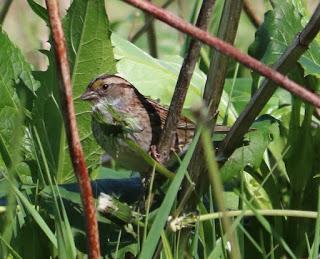Becoming an Amateur Naturalist Part 1: Getting Started

Step one: notice the thing. This can be harder than you might think!
Many people have found themselves enjoying the wildlife and nature in their yards and around local parks and trails in recent months. As you begin to pay attention to surroundings, you may become curious about the identities of the flowers, birds, bugs, and trees that you encounter. If so, wonderful! And welcome to the world of the amateur naturalist!*
It can be daunting to take your first walk outside and see so many different things, many of which can appear nearly identical. Is that yellow flower Wild Parsnip or Golden Alexander? That little brown bird looks the same as all the other little brown birds…how in the world do you tell them apart? What is making that noise out in the bushes? There are amazing local resources to help people learn about the world around us, such as Iowa Master Naturalists and [during non-pandemic times] bird walks with the Iowa City Bird Club or programs with Johnson County Conservation. But you can also learn a lot on your own!
Although I have been writing about wildlife on the Sycamore Greenway for several years, I am certainly not a professional–just someone with an interest and the time to learn about what I see and hear. And someone who has amassed an arsenal of resources to help me figure out what the heck I’m looking at, and why it is interesting.** So stay tuned to hear about how the numerous posts on the Sycamore Greenway page come to be, as I share some of the tips and resources that have helped me learn about and share our Greenway neighbors over the years.
Although there are benefits to being completely unplugged and immersed in nature, a camera can be your best friend if you want to learn more about what you see. A good camera and lens are wonderful, especially if you are interested in birds, but your phone is more than adequate for plants in particular.
The first step is to walk slowly and look closely. This is not an activity best done while biking, running, or otherwise exercising. It requires focus. Look at everything around you. Pay attention to what catches your eye. Try to pick out a particular flower and find others that are the same type. Keep an eye out for other flowers that are similar, but not exactly the same, and try to discern the differences in leaf shape and structure, or subtle differences in the flowers.
And don’t be afraid to stop and inspect something that looks a little out of place (this can sometimes be a risky endeavor). If you see a spider web, look to find the spider that made it. If a minuscule something jumps away from your footstep in the grass, try to follow it with your eye and get a closer look. If you hear a bird singing in a tree, stop and try to see it among the leaves.
And take pictures! Lots and lots of pictures. If you are looking at a plant, take a picture of the flower, a complete leaf, and the place where the leaves join the stem. If you are looking at an insect, try to get a shot from a few different angle, maybe top and side, or a butterfly with its wings open and closed. The more angles you have, the more possible identifiers you may have captured. How fortunate that we live in a time of digital photography, where hasty or poor photos don’t cost us a thing!
Start slowly. Pick out just a few individuals to try to identify at first, particularly those that are fairly common or distinctive. Take pictures, or take a video to capture sounds. Make note of where you saw the specimen (is it a plant in a wet area, or a disturbed edge? What plant is the insect on?), and be aware of the time of year for when you look to identify it (for example, there will be a greater variety of birds passing through during spring and fall migration than through the summer).
It can be awkward and may feel embarrassing at first to get some of those shots (my apologies to the many unsuspecting people over the years who have rounded a corner of the trail to be confronted with my rear end aloft as I creep along the grass taking pictures of teeny katydid nymphs, or are startled when I lurch out from the brush after chasing down a butterfly), but as long as you are aware of your surroundings, don’t block the trail, and offer up a cheerful greeting, most passersby don’t give you a second glance. Or maybe they do, but you’ll be too busy learning about your new friends to notice.
Next week: You’ve got your specimen photos…now what?
Originally published in Sycamore Greenway Friends.


